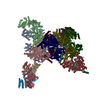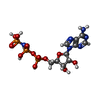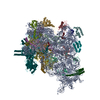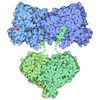+ データを開く
データを開く
- 基本情報
基本情報
| 登録情報 | データベース: PDB / ID: 7pfo | |||||||||
|---|---|---|---|---|---|---|---|---|---|---|
| タイトル | Core human replisome | |||||||||
 要素 要素 |
| |||||||||
 キーワード キーワード | REPLICATION / DNA replication / helicase / CMG / TIMELESS / TIPIN / CLASPIN / AND-1 / EPSILON / POLYMERASE / REPLISOME | |||||||||
| 機能・相同性 |  機能・相同性情報 機能・相同性情報cellular response to bleomycin / DNA secondary structure binding / detection of abiotic stimulus / replication fork arrest / regulation of nuclear cell cycle DNA replication / Switching of origins to a post-replicative state / Unwinding of DNA / cell cycle phase transition / cellular response to cisplatin / DNA replication initiation ...cellular response to bleomycin / DNA secondary structure binding / detection of abiotic stimulus / replication fork arrest / regulation of nuclear cell cycle DNA replication / Switching of origins to a post-replicative state / Unwinding of DNA / cell cycle phase transition / cellular response to cisplatin / DNA replication initiation / epsilon DNA polymerase complex / DNA strand elongation involved in mitotic DNA replication / GINS complex / mitotic DNA replication preinitiation complex assembly / nuclear origin of replication recognition complex / cellular response to hydroxyurea / nucleotide-excision repair, DNA gap filling / anaphase-promoting complex binding / mitotic DNA replication / alpha DNA polymerase:primase complex / DNA replication proofreading / CMG complex / DNA replication checkpoint signaling / single-stranded DNA 3'-5' DNA exonuclease activity / DNA replication preinitiation complex / MCM complex / replication fork protection complex / regulation of phosphorylation / mitotic DNA replication checkpoint signaling / double-strand break repair via break-induced replication / mitotic DNA replication initiation / regulation of DNA-templated DNA replication initiation / mitotic intra-S DNA damage checkpoint signaling / DNA strand elongation involved in DNA replication / 加水分解酵素; エステル加水分解酵素; 5'-リン酸モノエステル産生エンドデオキシリボヌクレアーゼ / positive regulation of double-strand break repair / inner cell mass cell proliferation / activation of protein kinase activity / branching morphogenesis of an epithelial tube / DNA synthesis involved in DNA repair / cochlea development / leading strand elongation / DNA unwinding involved in DNA replication / G1/S-Specific Transcription / Apoptotic cleavage of cellular proteins / replication fork processing / nuclear replication fork / mitotic G2 DNA damage checkpoint signaling / DNA replication origin binding / positive regulation of double-strand break repair via homologous recombination / DNA replication initiation / PCNA-Dependent Long Patch Base Excision Repair / Activation of the pre-replicative complex / error-prone translesion synthesis / embryonic organ development / cellular response to interleukin-4 / Activation of ATR in response to replication stress / response to UV / base-excision repair, gap-filling / DNA helicase activity / Gap-filling DNA repair synthesis and ligation in GG-NER / ciliary basal body / DNA damage checkpoint signaling / morphogenesis of an epithelium / Assembly of the pre-replicative complex / helicase activity / Recognition of DNA damage by PCNA-containing replication complex / lung development / Termination of translesion DNA synthesis / regulation of circadian rhythm / HDR through Homologous Recombination (HRR) / Dual Incision in GG-NER / DNA-templated DNA replication / Dual incision in TC-NER / Gap-filling DNA repair synthesis and ligation in TC-NER / Orc1 removal from chromatin / circadian rhythm / G1/S transition of mitotic cell cycle / cellular response to xenobiotic stimulus / nucleosome assembly / site of double-strand break / mitotic cell cycle / single-stranded DNA binding / Processing of DNA double-strand break ends / 4 iron, 4 sulfur cluster binding / histone binding / peptidyl-serine phosphorylation / DNA helicase / DNA replication / cell population proliferation / DNA-directed DNA polymerase / chromosome, telomeric region / DNA-directed DNA polymerase activity / nuclear body / Ub-specific processing proteases / cell division / intracellular membrane-bounded organelle / DNA repair / negative regulation of DNA-templated transcription / nucleotide binding 類似検索 - 分子機能 | |||||||||
| 生物種 |  Homo sapiens (ヒト) Homo sapiens (ヒト) | |||||||||
| 手法 | 電子顕微鏡法 / 単粒子再構成法 / クライオ電子顕微鏡法 / 解像度: 3.2 Å | |||||||||
 データ登録者 データ登録者 | Jones, M.J. / Yeeles, J.T.P. | |||||||||
| 資金援助 |  英国, 1件 英国, 1件
| |||||||||
 引用 引用 |  ジャーナル: EMBO J / 年: 2021 ジャーナル: EMBO J / 年: 2021タイトル: Structure of a human replisome shows the organisation and interactions of a DNA replication machine. 著者: Morgan L Jones / Yasemin Baris / Martin R G Taylor / Joseph T P Yeeles /  要旨: The human replisome is an elaborate arrangement of molecular machines responsible for accurate chromosome replication. At its heart is the CDC45-MCM-GINS (CMG) helicase, which, in addition to ...The human replisome is an elaborate arrangement of molecular machines responsible for accurate chromosome replication. At its heart is the CDC45-MCM-GINS (CMG) helicase, which, in addition to unwinding the parental DNA duplex, arranges many proteins including the leading-strand polymerase Pol ε, together with TIMELESS-TIPIN, CLASPIN and AND-1 that have key and varied roles in maintaining smooth replisome progression. How these proteins are coordinated in the human replisome is poorly understood. We have determined a 3.2 Å cryo-EM structure of a human replisome comprising CMG, Pol ε, TIMELESS-TIPIN, CLASPIN and AND-1 bound to replication fork DNA. The structure permits a detailed understanding of how AND-1, TIMELESS-TIPIN and Pol ε engage CMG, reveals how CLASPIN binds to multiple replisome components and identifies the position of the Pol ε catalytic domain. Furthermore, the intricate network of contacts contributed by MCM subunits and TIMELESS-TIPIN with replication fork DNA suggests a mechanism for strand separation. #1:  ジャーナル: Nature / 年: 2021 ジャーナル: Nature / 年: 2021タイトル: A conserved mechanism for regulating replisome disassembly in eukaryotes. 著者: Michael Jenkyn-Bedford / Morgan L Jones / Yasemin Baris / Karim P M Labib / Giuseppe Cannone / Joseph T P Yeeles / Tom D Deegan /  要旨: Replisome disassembly is the final step of eukaryotic DNA replication and is triggered by ubiquitylation of the CDC45-MCM-GINS (CMG) replicative helicase. Despite being driven by evolutionarily ...Replisome disassembly is the final step of eukaryotic DNA replication and is triggered by ubiquitylation of the CDC45-MCM-GINS (CMG) replicative helicase. Despite being driven by evolutionarily diverse E3 ubiquitin ligases in different eukaryotes (SCF in budding yeast, CUL2 in metazoa), replisome disassembly is governed by a common regulatory principle, in which ubiquitylation of CMG is suppressed before replication termination, to prevent replication fork collapse. Recent evidence suggests that this suppression is mediated by replication fork DNA. However, it is unknown how SCF and CUL2 discriminate terminated from elongating replisomes, to selectively ubiquitylate CMG only after termination. Here we used cryo-electron microscopy to solve high-resolution structures of budding yeast and human replisome-E3 ligase assemblies. Our structures show that the leucine-rich repeat domains of Dia2 and LRR1 are structurally distinct, but bind to a common site on CMG, including the MCM3 and MCM5 zinc-finger domains. The LRR-MCM interaction is essential for replisome disassembly and, crucially, is occluded by the excluded DNA strand at replication forks, establishing the structural basis for the suppression of CMG ubiquitylation before termination. Our results elucidate a conserved mechanism for the regulation of replisome disassembly in eukaryotes, and reveal a previously unanticipated role for DNA in preserving replisome integrity. | |||||||||
| 履歴 |
|
- 構造の表示
構造の表示
| ムービー |
 ムービービューア ムービービューア |
|---|---|
| 構造ビューア | 分子:  Molmil Molmil Jmol/JSmol Jmol/JSmol |
- ダウンロードとリンク
ダウンロードとリンク
- ダウンロード
ダウンロード
| PDBx/mmCIF形式 |  7pfo.cif.gz 7pfo.cif.gz | 2.9 MB | 表示 |  PDBx/mmCIF形式 PDBx/mmCIF形式 |
|---|---|---|---|---|
| PDB形式 |  pdb7pfo.ent.gz pdb7pfo.ent.gz | 表示 |  PDB形式 PDB形式 | |
| PDBx/mmJSON形式 |  7pfo.json.gz 7pfo.json.gz | ツリー表示 |  PDBx/mmJSON形式 PDBx/mmJSON形式 | |
| その他 |  その他のダウンロード その他のダウンロード |
-検証レポート
| 文書・要旨 |  7pfo_validation.pdf.gz 7pfo_validation.pdf.gz | 1.8 MB | 表示 |  wwPDB検証レポート wwPDB検証レポート |
|---|---|---|---|---|
| 文書・詳細版 |  7pfo_full_validation.pdf.gz 7pfo_full_validation.pdf.gz | 1.8 MB | 表示 | |
| XML形式データ |  7pfo_validation.xml.gz 7pfo_validation.xml.gz | 199.1 KB | 表示 | |
| CIF形式データ |  7pfo_validation.cif.gz 7pfo_validation.cif.gz | 321.5 KB | 表示 | |
| アーカイブディレクトリ |  https://data.pdbj.org/pub/pdb/validation_reports/pf/7pfo https://data.pdbj.org/pub/pdb/validation_reports/pf/7pfo ftp://data.pdbj.org/pub/pdb/validation_reports/pf/7pfo ftp://data.pdbj.org/pub/pdb/validation_reports/pf/7pfo | HTTPS FTP |
-関連構造データ
- リンク
リンク
- 集合体
集合体
| 登録構造単位 | 
|
|---|---|
| 1 |
|
- 要素
要素
-DNA replication licensing factor ... , 6種, 6分子 234567
| #1: タンパク質 | 分子量: 102034.102 Da / 分子数: 1 / 由来タイプ: 組換発現 / 由来: (組換発現)  Homo sapiens (ヒト) / 遺伝子: MCM2, BM28, CCNL1, CDCL1, KIAA0030 / 発現宿主: Homo sapiens (ヒト) / 遺伝子: MCM2, BM28, CCNL1, CDCL1, KIAA0030 / 発現宿主:  Trichoplusia ni (イラクサキンウワバ) / 参照: UniProt: P49736, DNA helicase Trichoplusia ni (イラクサキンウワバ) / 参照: UniProt: P49736, DNA helicase |
|---|---|
| #2: タンパク質 | 分子量: 91110.852 Da / 分子数: 1 / 由来タイプ: 組換発現 / 由来: (組換発現)  Homo sapiens (ヒト) / 遺伝子: MCM3 / 発現宿主: Homo sapiens (ヒト) / 遺伝子: MCM3 / 発現宿主:  Trichoplusia ni (イラクサキンウワバ) / 参照: UniProt: P25205, DNA helicase Trichoplusia ni (イラクサキンウワバ) / 参照: UniProt: P25205, DNA helicase |
| #3: タンパク質 | 分子量: 96684.852 Da / 分子数: 1 / 由来タイプ: 組換発現 / 由来: (組換発現)  Homo sapiens (ヒト) / 遺伝子: MCM4, CDC21 / 発現宿主: Homo sapiens (ヒト) / 遺伝子: MCM4, CDC21 / 発現宿主:  Trichoplusia ni (イラクサキンウワバ) / 参照: UniProt: P33991, DNA helicase Trichoplusia ni (イラクサキンウワバ) / 参照: UniProt: P33991, DNA helicase |
| #4: タンパク質 | 分子量: 82406.633 Da / 分子数: 1 / 由来タイプ: 組換発現 / 由来: (組換発現)  Homo sapiens (ヒト) / 遺伝子: MCM5, CDC46 / 発現宿主: Homo sapiens (ヒト) / 遺伝子: MCM5, CDC46 / 発現宿主:  Trichoplusia ni (イラクサキンウワバ) / 参照: UniProt: P33992, DNA helicase Trichoplusia ni (イラクサキンウワバ) / 参照: UniProt: P33992, DNA helicase |
| #5: タンパク質 | 分子量: 93010.273 Da / 分子数: 1 / 由来タイプ: 組換発現 / 由来: (組換発現)  Homo sapiens (ヒト) / 遺伝子: MCM6 / 発現宿主: Homo sapiens (ヒト) / 遺伝子: MCM6 / 発現宿主:  Trichoplusia ni (イラクサキンウワバ) / 参照: UniProt: Q14566, DNA helicase Trichoplusia ni (イラクサキンウワバ) / 参照: UniProt: Q14566, DNA helicase |
| #6: タンパク質 | 分子量: 81411.875 Da / 分子数: 1 / 由来タイプ: 組換発現 / 由来: (組換発現)  Homo sapiens (ヒト) / 遺伝子: MCM7, CDC47, MCM2 / 発現宿主: Homo sapiens (ヒト) / 遺伝子: MCM7, CDC47, MCM2 / 発現宿主:  Trichoplusia ni (イラクサキンウワバ) / 参照: UniProt: P33993, DNA helicase Trichoplusia ni (イラクサキンウワバ) / 参照: UniProt: P33993, DNA helicase |
-DNA polymerase epsilon ... , 2種, 2分子 AB
| #7: タンパク質 | 分子量: 59600.887 Da / 分子数: 1 / 由来タイプ: 組換発現 / 由来: (組換発現)  Homo sapiens (ヒト) / 遺伝子: POLE2, DPE2 / 発現宿主: Homo sapiens (ヒト) / 遺伝子: POLE2, DPE2 / 発現宿主:  Trichoplusia ni (イラクサキンウワバ) / 参照: UniProt: P56282 Trichoplusia ni (イラクサキンウワバ) / 参照: UniProt: P56282 |
|---|---|
| #8: タンパク質 | 分子量: 261855.266 Da / 分子数: 1 / 由来タイプ: 組換発現 / 由来: (組換発現)  Homo sapiens (ヒト) / 遺伝子: POLE, POLE1 / 発現宿主: Homo sapiens (ヒト) / 遺伝子: POLE, POLE1 / 発現宿主:  Trichoplusia ni (イラクサキンウワバ) Trichoplusia ni (イラクサキンウワバ)参照: UniProt: Q07864, DNA-directed DNA polymerase, 加水分解酵素; エステル加水分解酵素; 5'-リン酸モノエステル産生エンドデオキシリボヌクレアーゼ |
-タンパク質 , 5種, 7分子 CHIJKLQ
| #9: タンパク質 | 分子量: 66016.891 Da / 分子数: 1 / 由来タイプ: 組換発現 / 由来: (組換発現)  Homo sapiens (ヒト) / 遺伝子: CDC45, CDC45L, CDC45L2, UNQ374/PRO710 / 発現宿主: Homo sapiens (ヒト) / 遺伝子: CDC45, CDC45L, CDC45L2, UNQ374/PRO710 / 発現宿主:  Trichoplusia ni (イラクサキンウワバ) / 参照: UniProt: O75419 Trichoplusia ni (イラクサキンウワバ) / 参照: UniProt: O75419 | ||||||
|---|---|---|---|---|---|---|---|
| #14: タンパク質 | 分子量: 130098.148 Da / 分子数: 3 / 由来タイプ: 組換発現 / 由来: (組換発現)  Homo sapiens (ヒト) / 遺伝子: WDHD1, AND1 / 発現宿主: Homo sapiens (ヒト) / 遺伝子: WDHD1, AND1 / 発現宿主:  Trichoplusia ni (イラクサキンウワバ) / 参照: UniProt: O75717 Trichoplusia ni (イラクサキンウワバ) / 参照: UniProt: O75717#15: タンパク質 | | 分子量: 138903.031 Da / 分子数: 1 / 由来タイプ: 組換発現 / 由来: (組換発現)  Homo sapiens (ヒト) / 遺伝子: TIMELESS, TIM, TIM1, TIMELESS1 / 発現宿主: Homo sapiens (ヒト) / 遺伝子: TIMELESS, TIM, TIM1, TIMELESS1 / 発現宿主:  Trichoplusia ni (イラクサキンウワバ) / 参照: UniProt: Q9UNS1 Trichoplusia ni (イラクサキンウワバ) / 参照: UniProt: Q9UNS1#16: タンパク質 | | 分子量: 34600.223 Da / 分子数: 1 / 由来タイプ: 組換発現 / 由来: (組換発現)  Homo sapiens (ヒト) / 遺伝子: TIPIN / 発現宿主: Homo sapiens (ヒト) / 遺伝子: TIPIN / 発現宿主:  Trichoplusia ni (イラクサキンウワバ) / 参照: UniProt: Q9BVW5 Trichoplusia ni (イラクサキンウワバ) / 参照: UniProt: Q9BVW5#19: タンパク質 | | 分子量: 155184.703 Da / 分子数: 1 / 由来タイプ: 組換発現 / 由来: (組換発現)  Homo sapiens (ヒト) / 遺伝子: CLSPN / 発現宿主: Homo sapiens (ヒト) / 遺伝子: CLSPN / 発現宿主:  Trichoplusia ni (イラクサキンウワバ) / 参照: UniProt: Q9HAW4 Trichoplusia ni (イラクサキンウワバ) / 参照: UniProt: Q9HAW4 |
-DNA replication complex GINS protein ... , 4種, 4分子 DEFG
| #10: タンパク質 | 分子量: 23022.469 Da / 分子数: 1 / 由来タイプ: 組換発現 / 由来: (組換発現)  Homo sapiens (ヒト) / 遺伝子: GINS1, KIAA0186, PSF1 / 発現宿主: Homo sapiens (ヒト) / 遺伝子: GINS1, KIAA0186, PSF1 / 発現宿主:  Trichoplusia ni (イラクサキンウワバ) / 参照: UniProt: Q14691 Trichoplusia ni (イラクサキンウワバ) / 参照: UniProt: Q14691 |
|---|---|
| #11: タンパク質 | 分子量: 21453.713 Da / 分子数: 1 / 由来タイプ: 組換発現 / 由来: (組換発現)  Homo sapiens (ヒト) / 遺伝子: GINS2, PSF2, CGI-122, DC5, HSPC037 / 発現宿主: Homo sapiens (ヒト) / 遺伝子: GINS2, PSF2, CGI-122, DC5, HSPC037 / 発現宿主:  Trichoplusia ni (イラクサキンウワバ) / 参照: UniProt: Q9Y248 Trichoplusia ni (イラクサキンウワバ) / 参照: UniProt: Q9Y248 |
| #12: タンパク質 | 分子量: 24562.611 Da / 分子数: 1 / 由来タイプ: 組換発現 / 由来: (組換発現)  Homo sapiens (ヒト) / 遺伝子: GINS3, PSF3 / 発現宿主: Homo sapiens (ヒト) / 遺伝子: GINS3, PSF3 / 発現宿主:  Trichoplusia ni (イラクサキンウワバ) / 参照: UniProt: Q9BRX5 Trichoplusia ni (イラクサキンウワバ) / 参照: UniProt: Q9BRX5 |
| #13: タンパク質 | 分子量: 30114.236 Da / 分子数: 1 / 由来タイプ: 組換発現 / 由来: (組換発現)  Homo sapiens (ヒト) / 遺伝子: GINS4, SLD5 / 発現宿主: Homo sapiens (ヒト) / 遺伝子: GINS4, SLD5 / 発現宿主:  Trichoplusia ni (イラクサキンウワバ) / 参照: UniProt: Q9BRT9 Trichoplusia ni (イラクサキンウワバ) / 参照: UniProt: Q9BRT9 |
-DNA鎖 , 2種, 2分子 MN
| #17: DNA鎖 | 分子量: 26396.836 Da / 分子数: 1 / 由来タイプ: 合成 / 由来: (合成)  Homo sapiens (ヒト) Homo sapiens (ヒト) |
|---|---|
| #18: DNA鎖 | 分子量: 16407.533 Da / 分子数: 1 / 由来タイプ: 組換発現 / 由来: (組換発現)  Homo sapiens (ヒト) / 発現宿主: Homo sapiens (ヒト) / 発現宿主:  Trichoplusia ni (イラクサキンウワバ) Trichoplusia ni (イラクサキンウワバ) |
-非ポリマー , 4種, 12分子 






| #20: 化合物 | ChemComp-ZN / #21: 化合物 | #22: 化合物 | #23: 化合物 | ChemComp-SO4 / | |
|---|
-詳細
| 研究の焦点であるリガンドがあるか | Y |
|---|
-実験情報
-実験
| 実験 | 手法: 電子顕微鏡法 |
|---|---|
| EM実験 | 試料の集合状態: PARTICLE / 3次元再構成法: 単粒子再構成法 |
- 試料調製
試料調製
| 構成要素 | 名称: Core human replisome / タイプ: COMPLEX Entity ID: #8, #7, #3, #5-#6, #2, #1, #4, #10-#13, #9, #15-#17, #14, #18-#19 由来: RECOMBINANT |
|---|---|
| 分子量 | 実験値: NO |
| 由来(天然) | 生物種:  Homo sapiens (ヒト) Homo sapiens (ヒト) |
| 由来(組換発現) | 生物種:  Trichoplusia ni (イラクサキンウワバ) Trichoplusia ni (イラクサキンウワバ) |
| 緩衝液 | pH: 7.8 |
| 試料 | 包埋: NO / シャドウイング: NO / 染色: NO / 凍結: YES |
| 試料支持 | グリッドの材料: COPPER / グリッドのサイズ: 400 divisions/in. / グリッドのタイプ: Quantifoil R2/2 |
| 急速凍結 | 凍結剤: ETHANE |
- 電子顕微鏡撮影
電子顕微鏡撮影
| 実験機器 |  モデル: Titan Krios / 画像提供: FEI Company |
|---|---|
| 顕微鏡 | モデル: FEI TITAN KRIOS |
| 電子銃 | 電子線源:  FIELD EMISSION GUN / 加速電圧: 300 kV / 照射モード: FLOOD BEAM FIELD EMISSION GUN / 加速電圧: 300 kV / 照射モード: FLOOD BEAM |
| 電子レンズ | モード: BRIGHT FIELD / 最大 デフォーカス(公称値): 3500 nm / 最小 デフォーカス(公称値): 1500 nm / Cs: 0.1 mm |
| 試料ホルダ | 試料ホルダーモデル: FEI TITAN KRIOS AUTOGRID HOLDER |
| 撮影 | 電子線照射量: 39.8 e/Å2 / 検出モード: COUNTING フィルム・検出器のモデル: GATAN K2 SUMMIT (4k x 4k) |
| 画像スキャン | 動画フレーム数/画像: 40 |
- 解析
解析
| EMソフトウェア |
| ||||||||||||||||||||||||
|---|---|---|---|---|---|---|---|---|---|---|---|---|---|---|---|---|---|---|---|---|---|---|---|---|---|
| CTF補正 | タイプ: PHASE FLIPPING AND AMPLITUDE CORRECTION | ||||||||||||||||||||||||
| 粒子像の選択 | 選択した粒子像数: 490000 | ||||||||||||||||||||||||
| 3次元再構成 | 解像度: 3.2 Å / 解像度の算出法: FSC 0.143 CUT-OFF / 粒子像の数: 110000 / アルゴリズム: FOURIER SPACE / 対称性のタイプ: POINT | ||||||||||||||||||||||||
| 原子モデル構築 | 空間: REAL | ||||||||||||||||||||||||
| 拘束条件 |
|
 ムービー
ムービー コントローラー
コントローラー















 PDBj
PDBj



























































